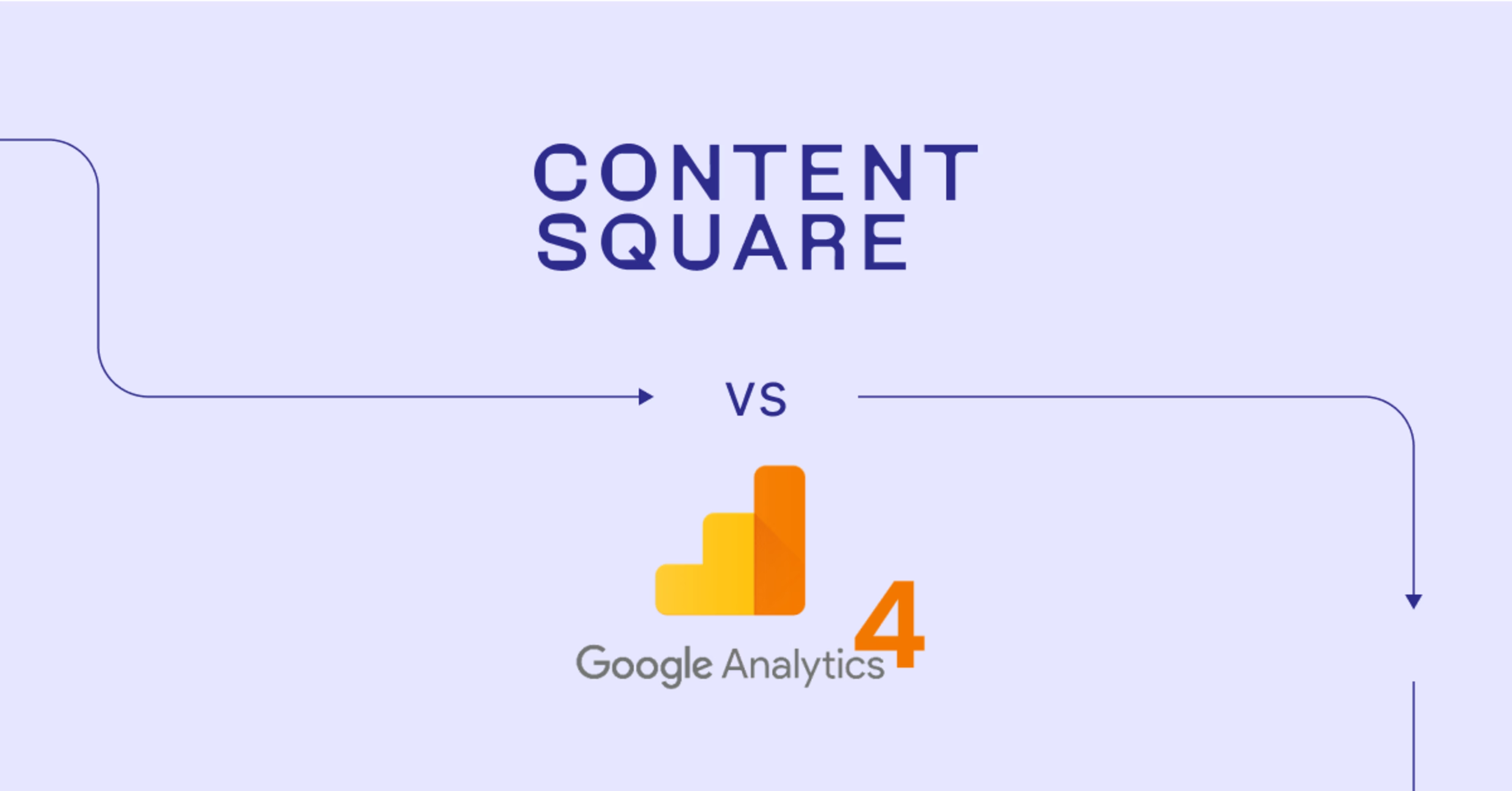The information on this page is correct as at 18/10/2025 to the best of Contentsquare's understanding.
Google Analytics has been the world’s most popular web analytics platform ever. For over two decades, most digital teams on the planet have managed their businesses based on Google Analytics data. It was known for being easy to learn and easy to use. That is until recently though, when Google made the switch from the former Google Analytics Universal Edition, to GA4.
TL;DR
Companies looking for alternatives to Google Analytics 4 (GA4) have found a solution in Contentsquare Product Analytics that enables them to more easily answer everyday questions about their website and app users with the benefit of Contentsquare’s industry-leading capability to auto capture behavioral data. Autocapture in Contentsquare has been refined over 10 years of R&D investment.
It is available for capturing in-page behavioral events for both websites and mobile apps
It has proven itself over and over again to provide huge time and cost savings compared to traditional analytics tools which require manual tagging whenever teams want to answer typical new questions
Unburdens engineering so they can focus on their main scope instead of tagging
Reduces noise with data governance features that retain auto captured events in the background while surfacing only the events that matter
Ultimately, provides a more complete data set which enables users to get better answers to questions, more quickly, and retroactively.
Contentsquare Product Analytics and GA4 are even better when combined with Contentsquare Experience Analytics. Over 1,000 enterprises and over a million websites today use Contentsquare Experience Analytics to transform their users’ ability to make data-driven decisions with the help of immersive visual insights into user experiences, frustrations, and their underlying root causes.
In a typical joint usage scenario,
GA4’s free or paid version may be used for advertising analytics purposes
Contentsquare Product Analytics is used to quickly answer everyday questions about behaviors and journeys once users land on the site or in the app
Contentsquare Experience Analytics answers why certain behaviors or experience issues are happening and how to improve outcomes.
Contentsquare Voice of Customer enriches these insights with direct user feedback
The combination helps teams
Manage their digital business and roadmap based on Northstar KPIs
Create journeys and content experiences that convert better
Create friction-free experiences by surfacing frustrations and their root causes
Create happy users by collecting feedback directly via surveys, feedback, and usability tests
Contact us to get recommendations for your specific use cases and to learn how Contentsquare can save you time, effort and costs.
Analytics tools were built for the experiences of their time
Google Analytics was originally created in an era when websites used to be mere electronic brochures back in the early 2000s. During the rise of ecommerce and lead gen websites in subsequent years, Google Analytics kept up with the trend by adding strong marketing and conversion reporting.
But today’s websites and apps are incredibly rich and interactive content experiences. Understanding user behavior and what’s working vs. not for engaging potential customers now requires much more detailed insights than pageview level data and conversion metrics. Especially so, for experiences on small mobile screens.
Perhaps 99% of user journeys and behaviors are happening inside pages and screens now, i.e.
Scrolling,
Engaging with content,
Hesitating,
Tapping various interactive features
Sometimes struggling with things that are slow or broken
To eventually continue and complete journeys within the same session and on the same device or another
Or to give up and bail instead
Understanding these rich experiences requires analytics built for the modern era. That’s exactly what led to the rise of modern analytics solutions, also known as Product and Experience Analytics. In line with this trend, Google Analytics Universal has famously been sunset now and replaced by Google Analytics 4, a.k.a GA4.
The move from Google Analytics Universal to GA4 did not go as smoothly as hoped for some users
GA4 is capable of more granular insights than the old GA Universal. But something unexpected happened in the transition to GA4 that we had not experienced with Google Analytics before. All of a sudden, the Internet was awash with users sharing their frustrations with the new version of the product. Here are just some of many articles you can find all over the web:
A lot of these concerns boil down to the need for extensive customization and manual tagging in order to be able to take full advantage of GA4’s capabilities. Teams want to use GA4 for analytics but they simply can’t seem to tag and customize it quickly enough to close data gaps for being able to answer the everyday questions that come up.
This is a typical concern also for many other traditional web, app, and product analytics tools that require manual tagging to capture in-page click events. Common complaints we hear from the users of these tools are
Data gaps: In theory, you can tag any event, but you can never tag every event. Data gaps are unavoidable.
LImited answers: If you didn’t tag it, it’s not retroactive, you can’t answer the question
High cost: Constant tagging is an effort, blocks data teams and burdens engineering teams who have a different scope,
The problem is worse for Apps: It’s problematic enough for websites, but tagging takes much longer, and requires more effort and time for instrumenting mobile apps
That’s why many companies come to Contentsquare for an alternative option.
GA4 and Contentsquare
GA4 and Contentsquare are both top-rated platforms for digital analytics. They are frequently compared to each other.
Over 1,000 companies are using Contentsquare Product Analytics to replace GA4 use cases because it helps them answer everyday questions more easily at lower total cost of ownership by auto capturing more complete data about their users’ behaviors without the need for manually tagging every click event that they want to understand better.
Even more frequently, GA4 and Contentsquare Experience Analytics are used in conjunction with each other. They even integrate so that Contentsquare visualizes the experiences and behaviors of Audiences defined in GA4. That enables teams to better understand their intent vs. actual experiences and prioritize what to enhance and fix based on business impact.
Whether you are best served by augmenting GA4 with Contentsquare Experience Analytics or replacing GA4 use cases with Contentsquare Product Analytics depends on your goals.
What are the main differences between Contentsquare vs GA4?
Instead of jumping into a tool comparison, start from your business goals. What are your biggest business challenges? Choose the platform that’s designed to help you achieve your goals.
Here’s an overview of the main use case differences between Contentsquare and GA4 from our perspective
Typical business goals and use cases | Contentsquare | GA4 |
|---|---|---|
Does it help improve marketing acquisition? | Yes, absolutely | Yes, absolutely |
How do we improve marketing acquisition? | Very Strong | Very Strong |
How do we create better products and drive user adoption and growth? | Very Strong | Strong,but limited due to typical data gaps |
How do we improve experiences, content engagement, and conversion? | Very Strong | Very light |
How do we surface obstacles and prioritize what to fix based on revenue impact? | Very Strong | - |
How do we create happier customers by collecting their feedback and making sense of it? | Medium | - |
Part of a larger platform? | 115+ integrationswith best of breed providers | Very Strong, e.g. Google Marketing Platform,Big Query, Gemini, Firebase. |
How do we improve marketing acquisition?
For marketers working on acquisition challenges, both GA4 and Contentsquare provide valuable metrics on campaign traffic and conversion.
User-Centric Reporting: Both track individual user journeys across devices and platforms, providing a clearer view of interactions.
Event-Based Tracking: Customizable event tracking captures specific actions, like clicks or purchases, for more detailed campaign performance insights.
Advanced Segmentation: Allows for audience segmentation based on behavior, helping marketers understand which groups drive the most value.
Beyond the basics, GA4’s strengths for improving marketing acquisition include
Seamless Integration with Google Ads: GA4 connects directly with Google Marketing Platform, enabling better campaign targeting and performance tracking.
Enhanced Audience Targeting: GA4 allows creation of custom audiences that can be easily imported into Google Ads for precise targeting and retargeting.
Attribution Modeling: GA4 offers multiple attribution models to assess how different marketing touchpoints contribute to conversions.
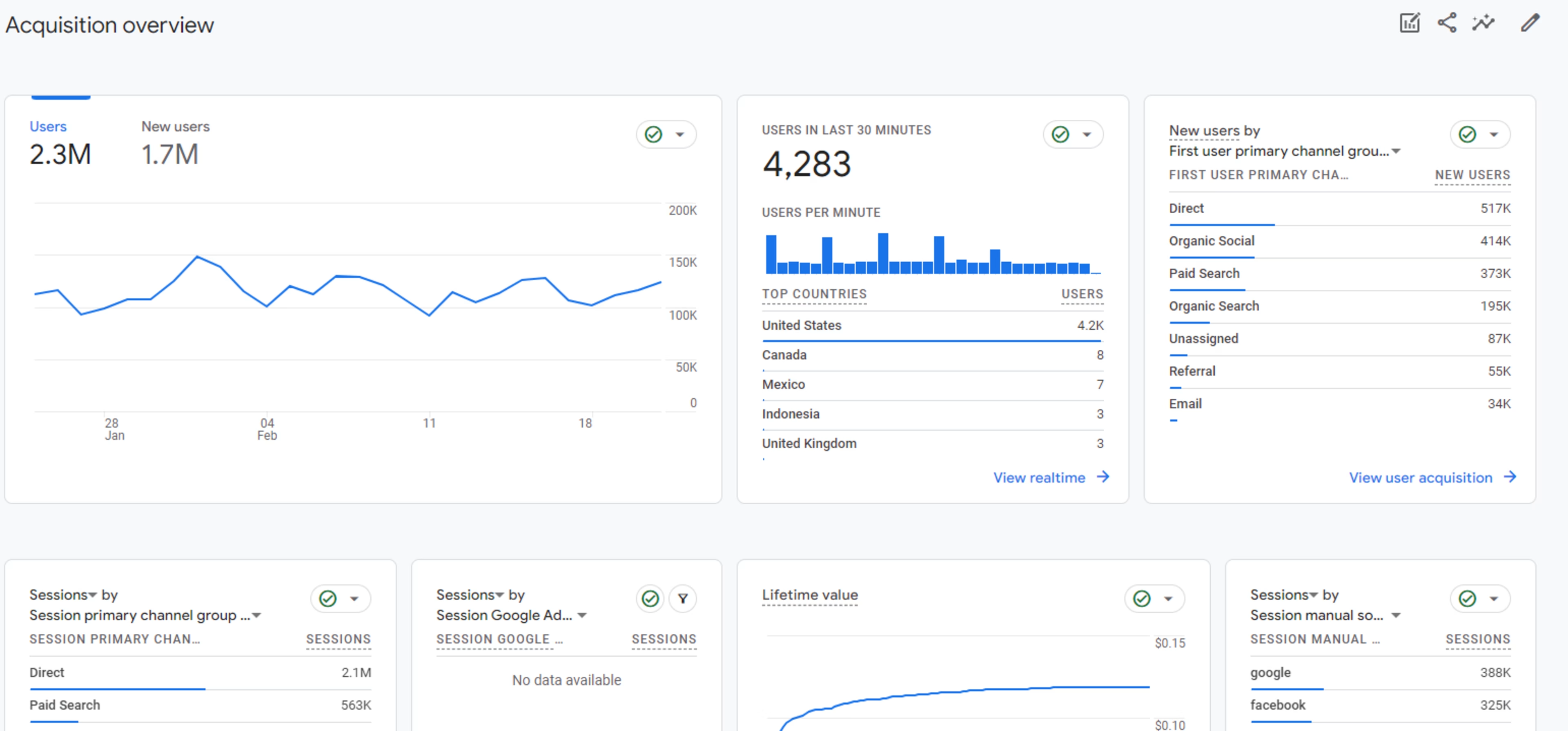
Tracking marketing analytics in an GA4 dashboard
Meanwhile, Contentsquare’s Web Analytics capabilities also let you gain deep insight into your marketing acquisition channels, e.g. traffic and conversion metrics by campaign. With the addition of Contentsquare Experience Analytics, your firepower for increasing Marketing ROI goes up dramatically.
GA4 Audiences integration into Contentsquare Experience Analytics
As documented In GA4 help pages, “Audiences are groups of users […] who have generated similar behavioral data or who share demographic or other descriptive data (e.g., same age group, same gender, were acquired by the same campaign). You can share audiences with the advertising products you use, like Google Ads, so you can market to specific groups of users.”
Wouldn’t it be helpful if you could import those same GA4 Audience definitions into Contentsquare to gain immersive visual insights into the behavior of these audiences when they browse your site? What content attracts them vs. doesn’t? What is their intent? What are their experiences?
That’s exactly what you can do with the integration between Contentsquare Experience Analytics and GA4:
Seamlessly bring your GA4 Audiences into Contentsquare to enhance your analysis and insights.
Filter any heatmap or search for replays by selecting the imported GA4 Audiences
Find improvement opportunities for journeys and content based on the audience’s wants and needs as demonstrated by their behaviors and struggles
Apply those lessons learned back to your ad campaigns in the Google Marketing Platform
😉 Perfect synergetic use case!
Contentsquare A/B testing integrations
Another example of Contentsquare’s value for improving Marketing ROI is through its integration with all leading A/B testing platforms, including AB Tasty, Optimizely, Monetate, Kaneleoono, and VWO.
For Marketers looking to run A/B tests for reducing bounces and increasing marketing campaign conversions, these integrations help to improve results in 3 ways:
Use Contentsquare’s AI-powered insights to identify new opportunities for experimentation, i.e. what are the best tests to run that are most likely to move the needle?
See exactly what impacts conversions and revenue during the tests using side-by-side Heatmaps
Understand exactly why variants won (and lost) to iterate more effectively on future tests and design changes
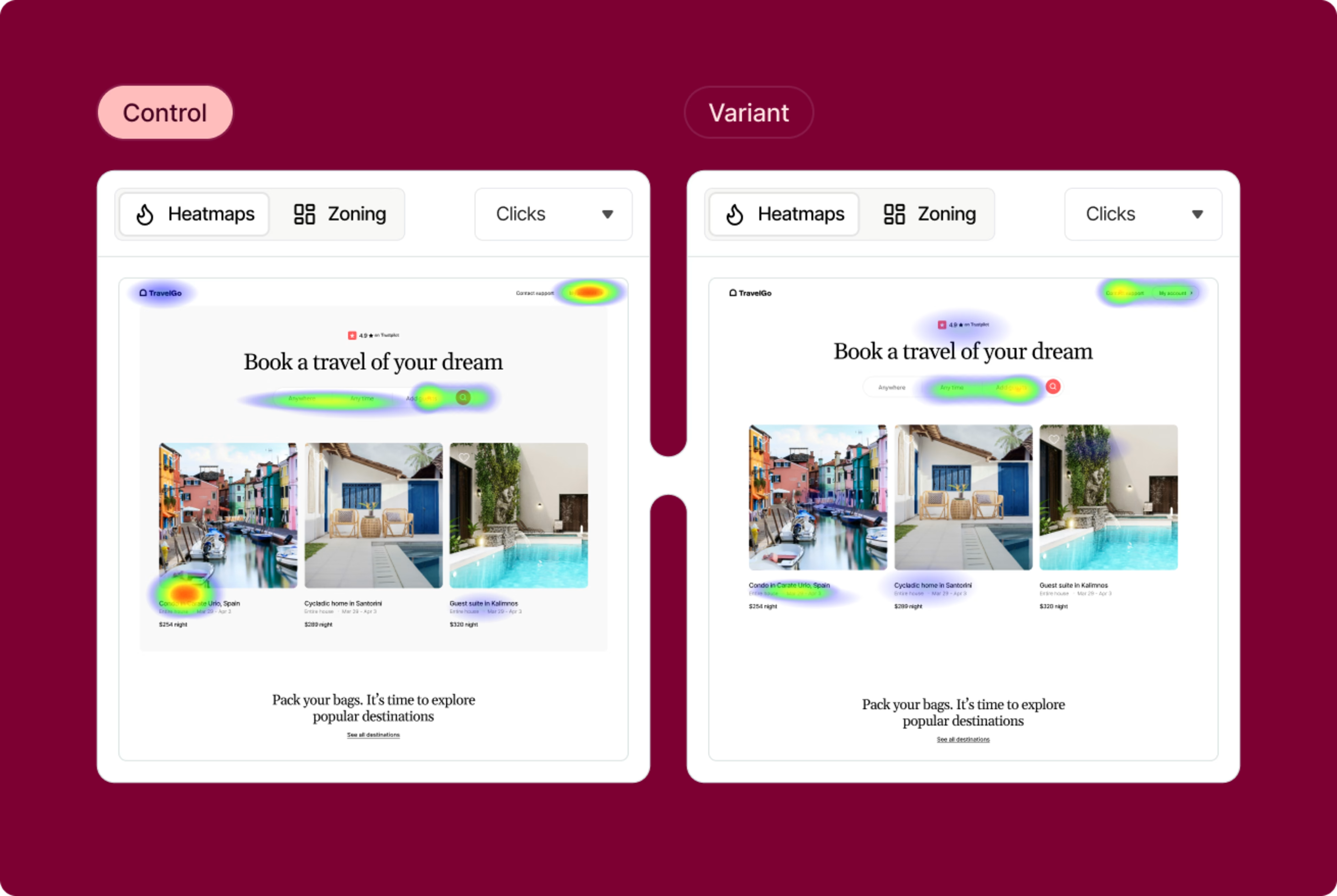
Visualize the outcome of A/B test variants with side-by-side Heatmaps in Contentsquare
👉 The result is a faster path to Marketing ROI, a win win.
What Contentsquare does better than GA4 (and why it matters)
There are plenty of use cases where Contentsquare provides advantages and additional tools above and beyond GA4. Here are some examples, based on the table of use cases that we saw earlier.
How do we create better products and drive user adoption and growth?
Both Contentsquare Product Analytics and GA4 are market leaders for web, app, and product analytics capabilities. You can use either one to
Track sign-ups and product usage
Measure onboarding and feature engagement
Stitch user behaviors across sessions and devices
Track retention and run cohort analysis
Create custom product analytics dashboards for different teams with templates for common use cases
Measure the success of SaaS products and ecommerce stores
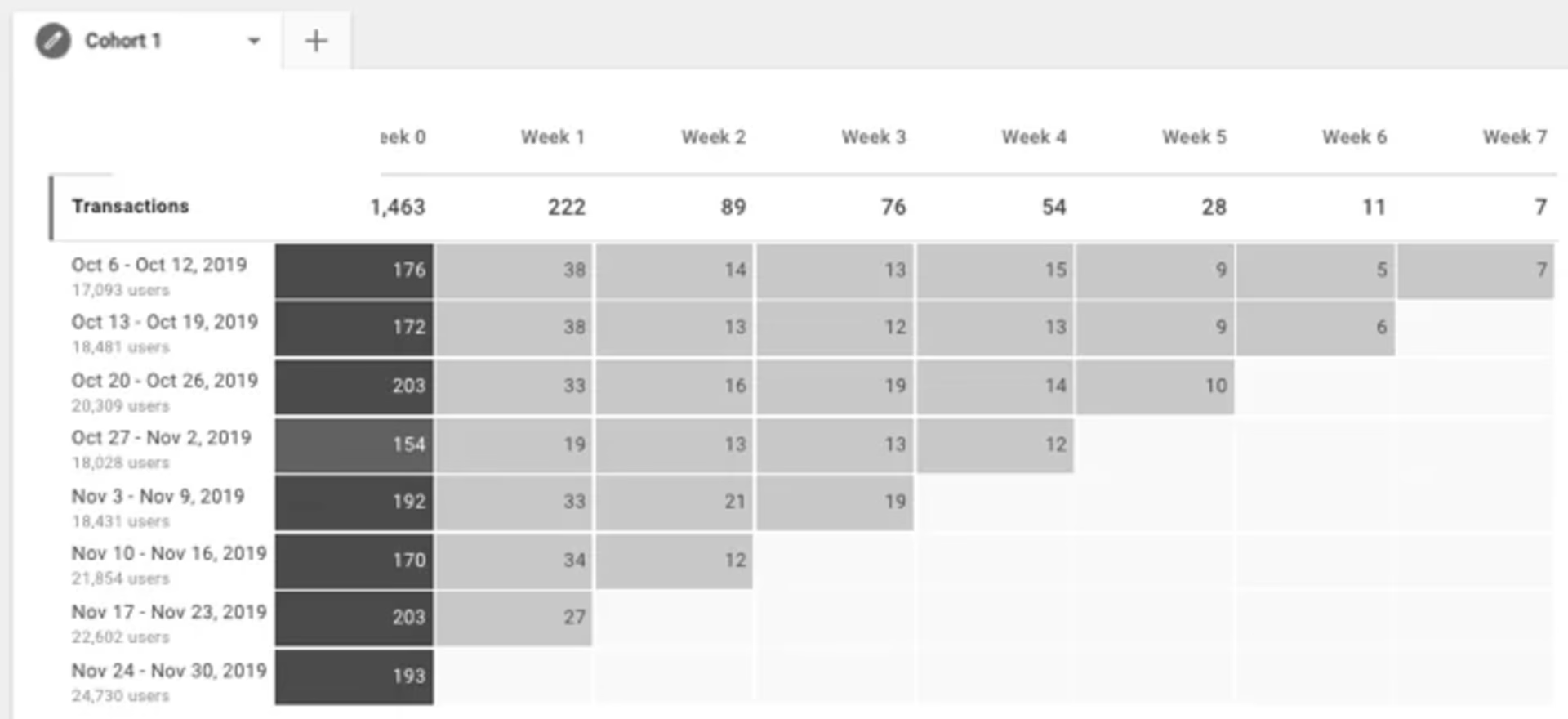
![[Visual] Retention analysis example in Pendo vs. Contentsquare](http://images.ctfassets.net/gwbpo1m641r7/20eJzeuoJNYHD3cOzDoUuU/58426f93140212c757625505bff979fb/unnamed-2024-10-18T104724.668.png?w=1920&q=100&fit=fill&fm=avif)
Cohort retention analysis in GA4 (top) vs. Contentsquare (bottom)
The biggest difference between Contentsquare Product Analytics and GA4 is the set-up, i.e. data capture. Contentsquare has refined its auto capture capabilities for websites and mobile apps with over 10 years of R&D investment. Today, it is the most widely used auto capture solution for web and app analytics in the industry. .
Contentsquare’s auto capture is market-proven to provide cost and time savings for gathering a more complete picture of in-page interactions so that teams can answer everyday questions at lower cost and effort:
No need to plan what click events to track in advance—Contentsquare automatically captures all in-page clicks, taps, field interactions, etc..
No need to loop engineering in every time there’s a change—unburden engineering to focus on their own scope
Flexibility to ask new questions of historical data— retroactive data means anyone can go back and troubleshoot or analyze any data point at any time
Reduced risk of missing critical data needed for answering questions—never worry about forgetting to track a specific event. A more complete data set means better and faster answers to questions.
Lower total cost of ownership—Save on the tremendous amount of effort and cost that is spent on traditional analytics for manual tagging.
Lower fees—Save on the extra fees that some analytics tools that are priced on the number of captured events charge when you increase the number of events you tag.
This approach saves time, money, reduces technical debt, and ensures you always have the data you need to make informed decisions. And it works right out of the box.
![[Visual] Manual tracking vs. autocapture](http://images.ctfassets.net/gwbpo1m641r7/1upLvWnDjOib3mspiWbMAP/f92482cc550184dfe41747b6a0ad3e6e/unnamed-2024-10-18T104718.598.png?w=3840&q=100&fit=fill&fm=avif)
Manual tracking vs. autocapture
Why does it matter?
Better answers to questions, delivered more quickly, means that Product teams can be more agile with prioritizing, triaging, and course correcting roadmap releases. This enables them to release more often, and put out better releases. That leads to more successful products that have a better chance at creating successful, loyal users and reaching their Northstar KPI targets.
How do we improve experiences, content engagement, and conversion?
The teams tasked with creating engaging and attractive brand experiences need a way to measure whether their content strategies are working. They need a way to attribute conversions and revenue back to the content elements that influence users along the way. That helps them strike the right balance between creating content rich experiences vs. shorter paths to conversion by deciding which content elements to keep vs. improve or reposition.
That’s why marketers and content teams add Contentsquare Experience Analytics to GA4, for its unique set of immersive visual insights:
Heatmaps show exactly which elements are driving conversions and revenue, e.g. on the home page or product pages —use them to make a case for changes, demonstrate the success of an experiment, and compare side-by-side segment behavior
Live browsing heatmaps enable you to overlay metrics directly over your website with just a click—use the CS Live Chrome extension to visualize how people interact within your website pages in real-time
Journey Maps visualize customer journeys in a way that is more helpful for discovery of unexpected behaviors. They display a top-down view of all user flow through the entire website or app at one glance. Similar pages are grouped into page types to reduce the noise. They even lets you compare journeys side by side, e.g. to surface the differences in journeys for users that complete their journeys vs. those that don’t.
By combining visual analytics and traditional charts, Contentsquare gives you ways to understand why users abandon their journeys and what content A/B tests are most likely to improve results. That use case of informing the best A/B tests to run for increasing conversions is one of the biggest value-drivers for companies using Contentsquare Experience Analytics.
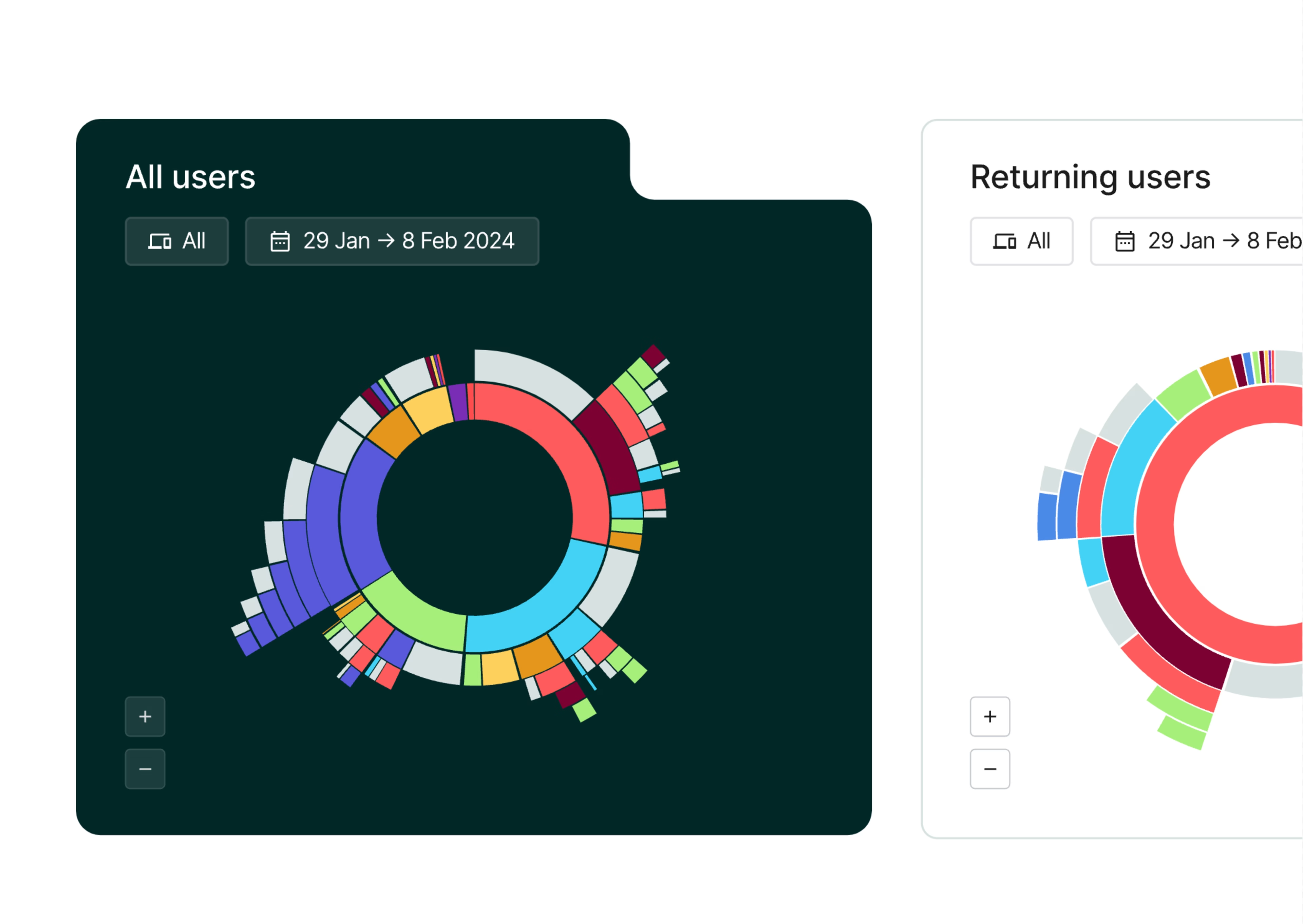
How do we surface obstacles and prioritize what to fix based on revenue impact?
No company can afford to lose customers and users because of frustrations on their sites and apps. That’s where session replay helps for stepping into the shoes of users and seeing what they are experiencing.
While Google provides speed metrics via Page Speed Insights and Google Lighthouse, there is a lot more that seasoned Experience Analytics and Monitoring tools such as Contentsquare provide for identifying points of friction, their root causes, and business impact.
Technical error analytics and resolution
Using Contentsquare you can
Replay sessions – so you can step into the shoes of users and see exactly what they experienced when they browsed your sites and used your apps.
Combine Error Monitoring + Session Replays for websites and mobile apps —automatically detect errors, then view relevant session replays to see exactly what users experienced before, during, and after the error occurred, e.g. JS errors, API errors, app crashes, console logged errors, and custom defined errors such as form validations.
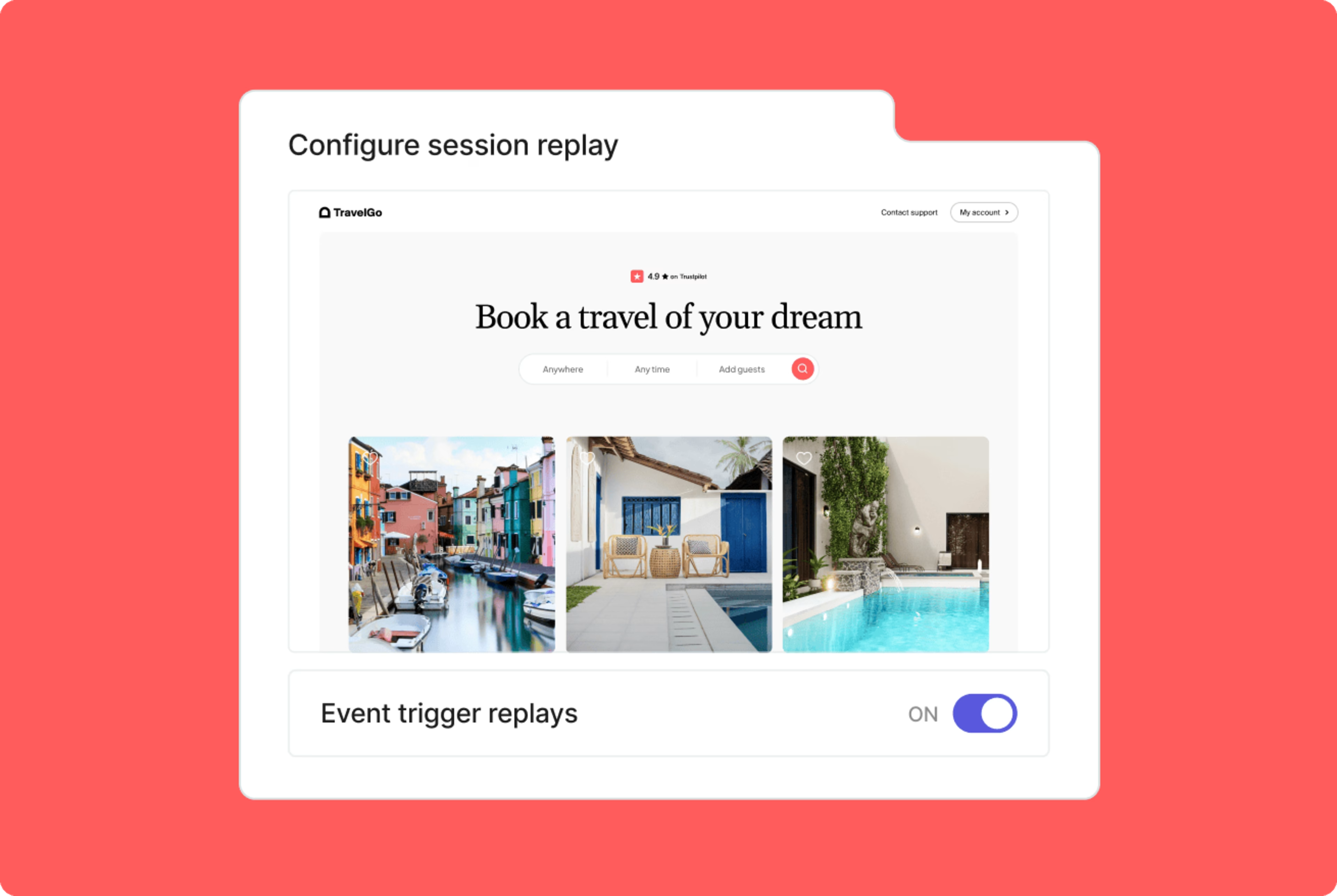
Example of session replay with error capture and impact quantification in Contentsquare
Save time with Frustration Scoring + Session Replays – by ranking which sessions to replay that are most likely to be insightful
Enable Advanced Support teams to resolve escalated issues by replaying the exact sessions related to customer service tickets, understanding root causes of issues down to errors, granular network details, request/response headers, and bodies.
Ensure security by enabling only authorized personnel to decrypt customer data needed for handling the customer’s service tickets
Enable engineers to see the full waterfall of network details behind every replay so they can understand what leads up to bugs and fix them quickly/
Get customizable real-time error alerts and dashboards that rally your team around critical issues
Make it easy to file tickets via Jira or rally teams to action via Slack and Microsoft Teams.
Save time focusing in high-impact optimizations with Contentsquare’s AI-powered insights such as Frustration Score
Perhaps the two most popular capabilities in Contentsquare for technical teams tasked with ensuring friction-free experiences are text search and 1-click impact quantification.
Retroactive text search in Contentsquare enables teams to
Surface and quantify all occurrences where site users encountered unexpected error messages of any kind, e.g. “Oops, something went wrong.”
Visualize how users experience these messages,
To learn things that technical teams didn’t already know from their APM tools such as Dynatrace, Datadog, etc.,
1-click impact quantification of behaviors and errors directly from session replay.
Spot any issue or error? Simply select the issue or behaviors leading up to it and quantify with one click to see how many others experience the same problems
Contentsquare automatically compares the segment of customers that experience the issue vs. those that don’t experience it at that point to calculate the true impact of the problem
This is what enables teams to go from one to many and prioritize the issues that will actually move the needle for the business and for customers.
Speed Analysis
While Google provides speed metrics via Page Speed Insights and Google Lighthouse, these tools are often used in conjunction with Contentsquare for a comprehensive view of performance.
Contentsquare provides speed analysis based on real user monitoring (RUM) to identify performance issues affecting conversion. Most importantly, this lets you quantify the conversion impact of slow speeds in Contentsquare. Perhaps there are content elements that are highly visual but may slow down your web pages. Knowing whether these content elements drive higher conversion will let you make an informed decision whether to keep, improve, or remove them.
Contentsquare also provides additional Speed Analysis tools based on Synthetic Monitoring, i.e. lab testing. Teams use these with Google tools to
Test experiences from different fixed geographic locations
Test experiences at regular intervals
Test scenarios of critical journeys, e.g. checkout.
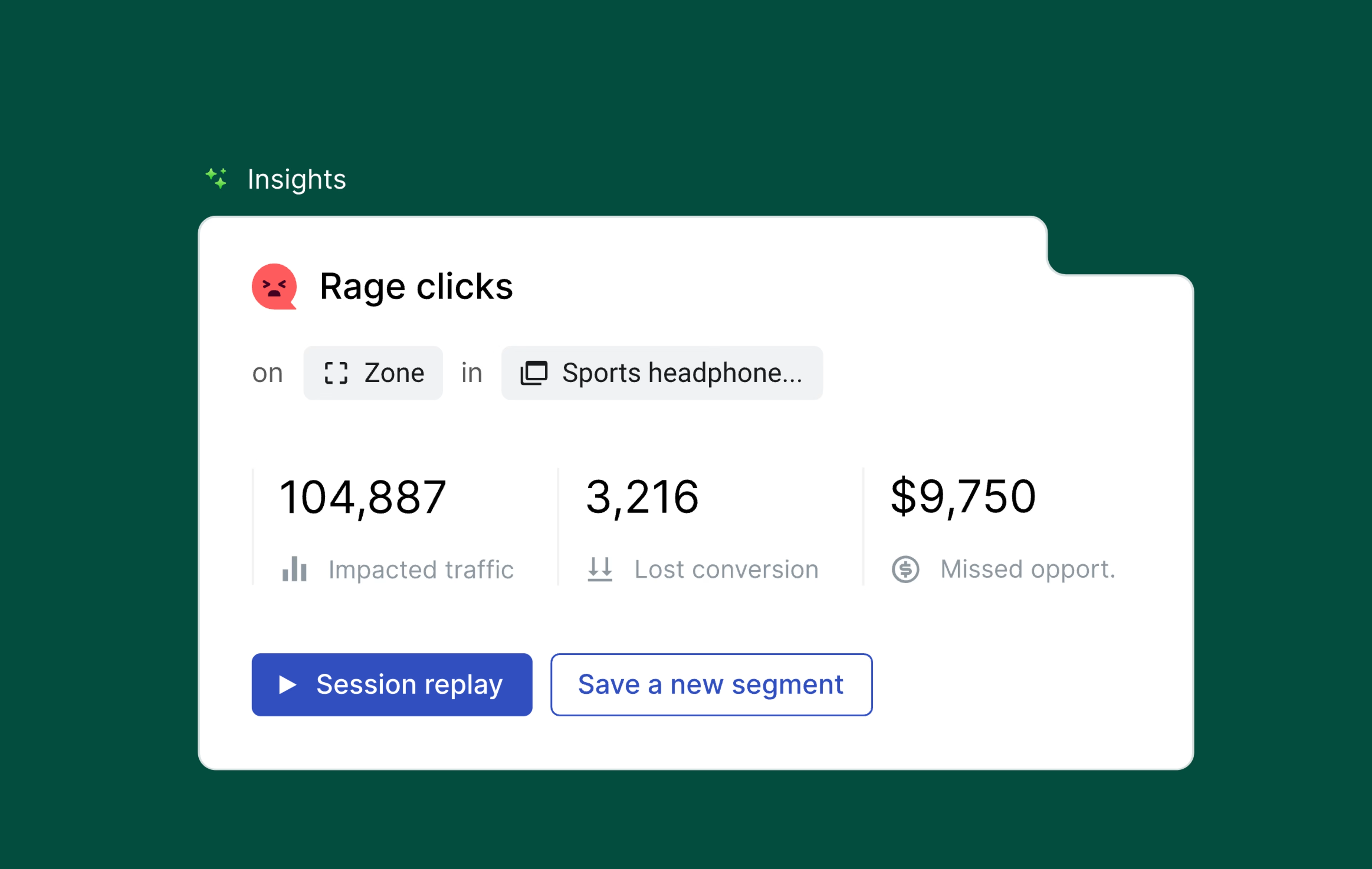
Example of quantifying the business impact of poor performance
UX Problems
Oftentimes, websites and apps work exactly as designed, but too many users are confused and frustrated anyways. Catching these issues requires data that goes beyond link click data captured by typical web and product analytics tools. For example, in Contentsquare you will also be able to visualize
Clicks on un-clickable content where users think something should be clickable
Recurring or rage clicks, a telltale sign that something is not quite right.
Clicks leading to errors
Multiple repeated form field interactions suggesting struggle and too much effort
Automated form analysis with metrics such as drop-rates, refill-rates, blank rates
Voice of Customer tool integrations for replaying sessions of users that rated experiences poorly to understand what led up to their frustrations
Side by side journey analysis, e.g. to compare journeys where users rated their experience 5-stars vs. just 1 star
And much more
The depth and breadth of the capabilities for Experience Monitoring in Contentsquare makes it easy to see why technical teams flock to the solution for ensuring smooth operations, no matter whether they may use it alongside GA4 or with Contentsquare Product Analytics.
How do we create happier customers by collecting feedback and listening better?
Voice of Customer (VoC) feedback gives you direct access to what’s going on in the minds of your most important business asset—your customers.
VoC tools empower teams across the organization to make data-driven decisions:
Marketers can refine campaigns based on customer sentiment
Product teams can prioritize features that resonate with users
Customer support can address common pain points
Executives can gauge overall satisfaction and loyalty
All this leads to improved customer experiences and increased business growth.
Google doesn’t today provide a native VoC tool—you’ll need to integrate with other paid tools like Survicate or Sprig to collect feedback responses and connect them to your quantitative data.
With Contentsquare, you have the option to integrate or use built-in VoC tools, including
Surveys—AI-powered for any use-case like exit-intent surveys and Net Promoter Score® (NPS) surveys
Feedback buttons—collect effortless feedback anytime with contextual screenshot capture
Intelligent analysis—transform qualitative data into actionable metrics with AI survey results and sentiment analysis
For Contentsquare customers, the focus is on the ability to make sense of feedback at scale with the help of
Session replay: 1-click to replay experiences leading up to feedback
Segmentation, e.g. for Journey Analysis and Heatmaps: Compare behaviors of users that rated experiences highly vs. poorly
Root cause analysis: Combine Voice of Customer with Contentsquare Experience Analytics to reveal why users are running into frustrations, e.g. whether it is due to slow speeds, technical errors, UX confusion, or all of the above
1-click Impact Quantification from replay: Zoom out from any one feedback to all users to quantify how many other users ran into the same frustrations even if they didn’t leave feedback, and what was the impact on conversion and revenue.
Is Contentsquare or GA4 better for your team?
It depends on what your primary reason for using a platform like GA4 is. If it’s measuring web analytics pageviews and understanding journeys at a high level, you can achieve your goals with either platform. But Contentsquare Product Analytics has proven itself over 10 years to be providing huge cost and time savings thanks to its autocapture architecture. Over a thousand companies use it to answer everyday questions that are just too hard and too costly to answer with traditional analytics that require manual tagging.
If it’s whole-business growth, Contentsquare is the only all-in-one platform that combines product and comprehensive experience analytics, monitoring, and Voice of Customer capabilities to tackle growth from all angles. These are indispensable, whether they are used as a companion to GA4 or with Contentsquare Product Analytics
The only way to really know which solution best aligns with your team’s needs is to experience it for yourself—take the 6-minute Contentsquare product tour and see how Contentsquare can outperform GA4 for your team.
Contentsquare vs GA4 FAQs
Net Promoter®, NPS®, NPS Prism®, and the NPS-related emoticons are registered trademarks of Bain & Company, Inc., NICE Systems, Inc., and Fred Reichheld. Net Promoter ScoreSM and Net Promoter SystemSM are service marks of Bain & Company, Inc., NICE Systems, Inc., and Fred Reichheld.
![[Visual] Contentsquare's Content Team](http://images.ctfassets.net/gwbpo1m641r7/3IVEUbRzFIoC9mf5EJ2qHY/f25ccd2131dfd63f5c63b5b92cc4ba20/Copy_of_Copy_of_BLOG-icp-8117438.jpeg?w=1920&q=100&fit=fill&fm=avif)
We’re an international team of content experts and writers with a passion for all things customer experience (CX). From best practices to the hottest trends in digital, we’ve got it covered. Explore our guides to learn everything you need to know to create experiences that your customers will love. Happy reading!
